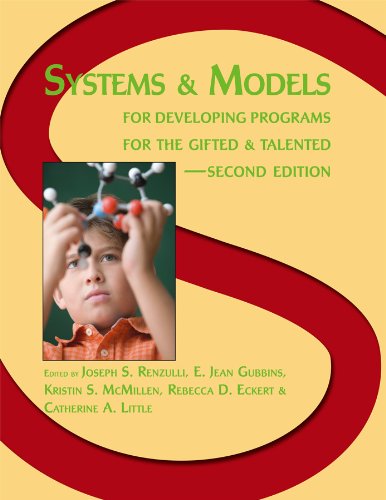Items related to Systems and Models for Developing Programs for the...

"synopsis" may belong to another edition of this title.
The book is interesting, organized, and easy to understand. Some authors include anecdotes that make for interesting reading, such as Susan Baum's story of Melanie, a gifted twice-exceptional student who couldn't read or write, or James Borland's anecdote of the outraged parent who stood up at a meeting and questioned if gifted students were being taught critical thinking, whether her son (who was not in the gifted program) was being taught "uncritical thinking." Some authors use visual diagrams to help the reader conceptualize the model, as in George Betts' and Jolene Kercher's chapter on the Autonomous Learner Model. Authors often discuss specific steps required to implement the models, as in Carolyn Callahan's chapter on The Practitioner's Guide to Program Evaluation (PGPE), and many include forms that are necessary or useful for implementation, as in Sally Reis' and Joseph's Renzulli's chapter on The Schoolwide Enrichment Model (SEM). Many of the chapters provide a list of additional resources for the reader who wants to learn more. The authors appear to understand that in the current age of accountability is it important to provide credible research supporting the models, and therefore many chapters include a summary of research to date on the effectiveness of models. Finally, a particularly helpful feature of the new edition is the inclusion of discussion questions that promote comprehension of the model.
If there is a concern with the text, it is that some of the chapters would have benefited from the inclusion of additional explanatory material. For example, some authors did not include visual diagrams where it might have been helpful to the reader's understanding of the complexities of the models. Also, the book would have benefited from the inclusion of an index. However, the positives far outweigh the negatives. Teachers, administrators, policy makers, university faculty and students will find that Systems and Models is an updated, helpful text that will assist them as they navigate the sometimes murky waters in the field of gifted education. It is especially a must-buy for any committee members involved with implementing (or changing) gifted programs and services within a school district. The "Golden Rule" in gifted education is that our definition of who is gifted should match our identification practices and which programs/services we provide. Systems and Models is the book that should enable us to do just that. --Nancy N. Heilbronner, Ph.D., Western Connecticut State University
"About this title" may belong to another edition of this title.
- PublisherCreative Learning Press
- Publication date2009
- ISBN 10 1931280118
- ISBN 13 9781931280112
- BindingPaperback
- Edition number2
- Number of pages704
- EditorJoseph S. Renzulli, E. Jean Gubbins, Kristin S. McMillen, Rebecca D. Eckert, Catherine A. Little
- Rating
Buy New
Learn more about this copy
Shipping:
FREE
Within U.S.A.
Top Search Results from the AbeBooks Marketplace
Systems and Models for Developing Programs for the Gifted and Talented
Book Description Softcover. Condition: New. 2nd. Now completely revised and expanded, Systems and Models includes chapters on the major systems and models for developing programs for the gifted, including the Autonomous Learner Model, the Integrative Education Model, the Multiple Menu Model, the Purdue Three-stage Model, the Schoolwide Enrichment Model, and Levels of Service. Forty-two experts (Baum, Benbow, Clark, Kolloff, Meeker, Reis, Rimm, Sternberg, Tomlinson, et al.) in gifted education contributed to 25 chapters. Each chapter includes a comprehensive, yet concise discussion of the model, theoretical underpinnings, research on effectiveness, and considerations for implementations. Discussion questions follow each chapter. This resource is a must-have for educational-psychology courses and for school boards considering different models. Seller Inventory # DADAX1931280118
Systems and Models for Developing Programs for the Gifted and Talented
Book Description Paperback. Condition: New. Seller Inventory # Abebooks454714

